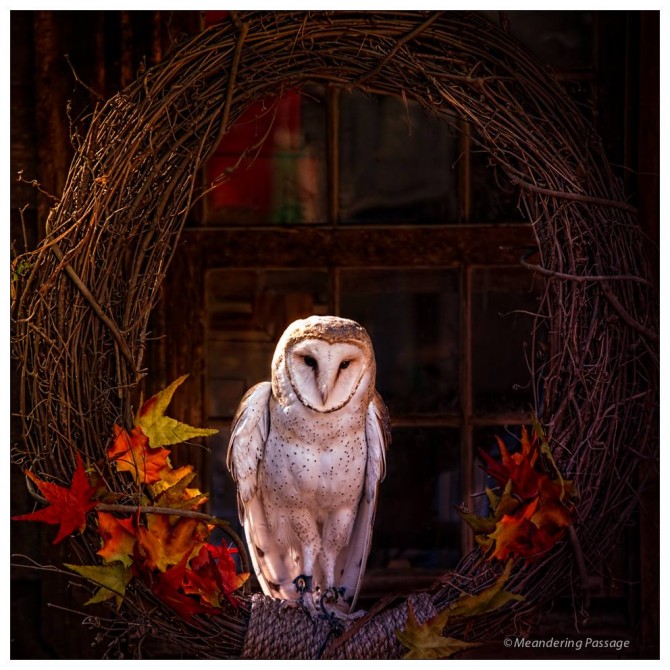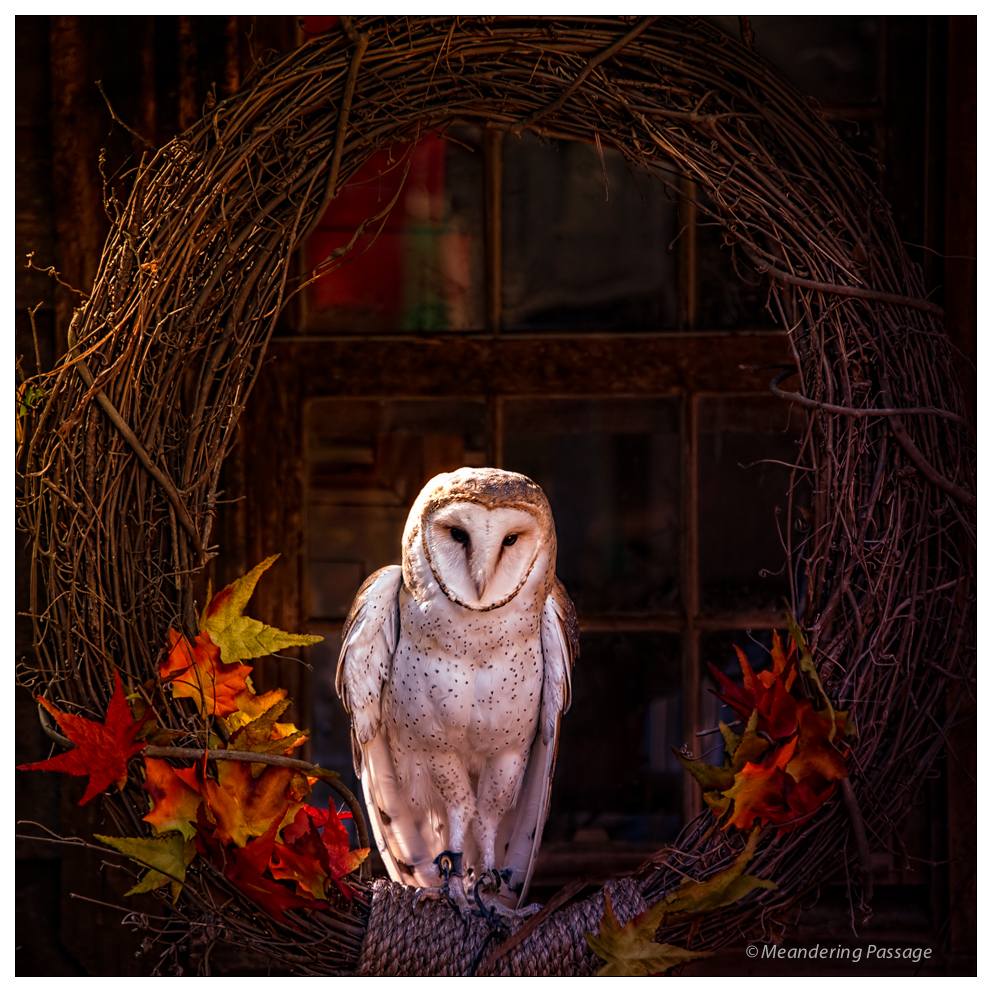It seemed a good autumn image…
Note: I noticed the thumbnail and this middle sized image here have a rather reddish tint to them the full size uploaded image (click image above) or the original does not. More of, or related to, the WordPress image resizing mischief Ken wrote of ??
Note Follow-up: With a little research I made an adjustment to lessen the JPEG compression WordPress was using. While this is to a certain degree subjective it seems to have helped with the tint “I was seeing.”
Discover more from Meandering Passage
Subscribe to get the latest posts sent to your email.



That is odd! I have seen shifts in exposure and contrast but never a color shift.
Great photo. From the Raptor Center outing?
Ken, thanks. Yes the Raptor Center.
I’ve seen slight shifts in saturation before…or at least it appeared to be a slight increase of saturation. This has to be happening in the WordPress image resizing/compression process as the full size image (when you click on the one above) doesn’t show it and that was exported/uploaded straight from LR and is what all the other image sizes are created from.
It’s not just recent…I’ve noticed it for a while with certain images.
I’m sorry Earl, but I see no difference at all between the “large” and “small” images on my monitor. Neither has what I would call a reddish tint (although there certainly is plenty of red in the image).
For one thing, they’re similar in size (according to the “properties” listed). The bigger one is 144 KB at 654 x 654 pixels, and the smaller one is 124 KB at 610 x 610 pixels. That is not nearly enough size difference to change how the image looks. If you’re seeing a change from one to the other, size isn’t the cause.
Ken mentioned on his site (in a response to one of my comments) that he was only using the Windows color calibration system, which is essentially the same as using nothing at all. If you’re not calibrating your monitor, then you can’t even begin to discuss how specific images look across different internet sites. It’s more complicated then that, of course, but you have to have a starting point. And again, on my calibrated monitor, there is absolutely no color change or shift in these 2 images. They look the same. So in my opinion, WordPress has not changed them.
Paul, I’m glad you cannot see it now because it ‘s not noticeable for me either at the moment and yes my monitors are regularly calibrated using a third party device/application — a tint of the two smaller images was noticeable at the time of posting and little glitches like this spur me to find both reason and solution. :-)
Late last night with a little research I added a filter to my themes “function.php” file to lessen the compression WP is using for JPEG images (and reprocessed) — this seemed to have helped. Since I’m careful to keep image file sizes small anyway this doesn’t cause any significant size penalty.
I haven’t had a chance to update the note in the body about this adjustment but I will now.
Thanks for the feedback!
The two make a fine autumn picture. I always like the detail and vivid colors of fall.
Hi Don, Thanks! Gotta love Fall!
It’s for damn sure I’m no computer whiz, Earl, but when I look at the properties of images I’ve posted recently, I find that they’re exactly the same size and dimensions that I “created” when I turned them into JPEGs. The “Standing Straight” image, for example, became a 546 KB JPEG with a long dimension of 850 pixels. After uploading it to WordPress, it hasn’t changed. In terms of size, there was no compression.
My question, then, is whether WordPress is doing anything to uploaded images if they’re within an acceptable range. And mine are definitely on the “large” side, I think.
Paul, I’ll not claim I’m an expert either but from looking at the code and reading the findings of others, here’s what “I think” I know about how WordPress handles Images.
In the WordPress Setting/Media we define three sizes for inserting into our post (thumbnail, medium & large.) WordPress used these settings to create resized/compressed images of the original image we choose and upload when creating post. I believe the original image is not changed – for instance the original image I uploaded for this post was 992×992 (and still is), but in the media settings I specified a large size (670×670) in the post and a thumbnail (300×300) for the front page. These two JPEG image sizes WordPress created from the original. When you click on the large size image above it’s the original (992×992) image displayed.
When resizing JPEG images WordPress by default does a JPEG compression at 90%. Nine times our of ten I’ve not had any problem with this…but there has been times when I’ve notice a slight quality loss or shift in the resized images.
For my workflow, I do compression in LR on export to JPEG…where I can view, change and re-export if needed. Then I’d just as soon WordPress didn’t do much additional compression (currently set at 95% but may change to 100% — no compression.) For example my original 992×992 JPEG image for this post is only 140KB…it was already compressed from LR.
Google robots now use site performance as part of their ranking so it can be important to keep image files as small as possible.
For what it’s worth, that’s my current understanding and practice. :-)
What you say is probably true, Earl. I think you know a whole lot more about this stuff than I do. My only question has to do with your Google remark.
If you have a photographic blog, where images are the main attraction, it’s a disadvantage to go “small” (in my opinion). Looking at thumbnails isn’t the best way to view an otherwise good photograph. It might help “site performance”, but to me that’s counter-productive, isn’t it? I’d rather see the image in its full size format as soon as possible. It doesn’t matter to me if I have to wait a couple of extra seconds for the image to load.
For users that regularly view your photo blog I’d somewhat agree with you. But…
I don’t try and drive traffic but at the same time I’m not against making it easier for people to find my blog. For example, if I didn’t know about your blog and was doing a Google search for photos of the southwest U.S., Google rank may make the difference in your site being on the first couple of pages or on page nine — very few people get to links from page nine of a Google search.
Is this important? Using Google Analytics, 73% of the traffic visiting my site comes from search engines…Google, Bing, Yahoo, etc. Now, not many of them stay or return but a few do. That photo I took in Italy which an Italian Newspaper picked up and published was found via a search.
Then there’s also research showing visitors are more likely to return to a site which is responsive and loads quickly. We must remember not all visitors have 5-20mb broadband Internet connections.
It’s also about balance and the medium we’re using. I dare say the quality of my original image uploaded to this post at 140Kb is scarcely discernible from a non-compressed version at over 500Kb when viewed on the web at 72-100dpi.
Sorry, I didn’t mean to be so long winded! :-)
I’m not seeing a color shift or anything unusual. Which is good, cuz this is a wonderful image!
John, I made a change last night in WordPress to eliminate the shift I thought I was seeing…so I don’t see it today either. Thanks!
Awesome image, Earl, as they are an impressive bird and one I enjoy seeing images of. As I’m not techie savvy it is all a mystery to me. I upload images that are 820 x 545 but post images that are 640 x 425. I see a difference between the compressed image and the original but that does not bother me that much. I hope visitors will enlarge to see the colors and tones as I exported from LR. Again, I love this image!
Thanks, Monte.
Looks fine to me here on my iPad Earl. Very creative concept, I love the circle framing.
Thanks, Mark.